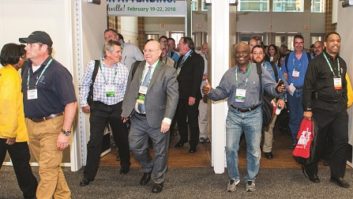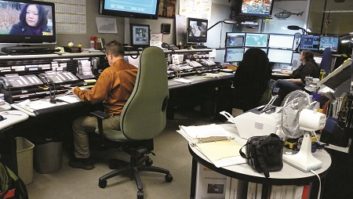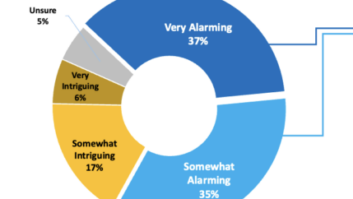As you take a look at the photos here, don’t let some old salt convince you this is some kind of newfangled beam tilt!
(click thumbnail)Fig. 1: The tower shows a serious bend.
(click thumbnail)Fig. 2: Professionally dismantled, the tower is allowed to fall on itself.
(click thumbnail)Fig. 3: Gravity does its thing.
(click thumbnail)Fig. 4: The finished product.
Personal Achievement Radio DOE Winston Hawkins, a frequent contributor to this column, sent these shots of a site his group acquired. Fortunately, there was escrow money to cover the replacement, because the tower was useless.
This series of photos is a good example of why an engineering due-diligence inspection is necessary when properties are acquired. During his inspection, Winston discovered this tower was unsafe; after the acquisition, it was professionally felled and replaced. Save yourself this trouble and expense. Thoroughly inspect any property your owner is planning to buy.
In addition to a physical inspection, check the lease on the property; if the property is included, ensure that the title is clear.
A contract engineer recently told me about a station purchased by a client who did not see the value of an engineering due-diligence inspection. After the sale, the engineer was reading over the lease for the property where the towers were located. He discovered there are only three years left on the lease. It’s a four-tower DA! Everything was disclosed; the owner simply didn’t read the fine print. No wonder the former owners wanted to sell the property.
Just as important is the omission of some aspect of an inspection. The tables could be reversed and you could be the one who misses the fine print on a lease. Unless you feel qualified, bring in a professional. This is true especially if you are a contractor who owns your own shop.
Missing something like this could ruin your business, a reason many contract firms carry “errors and omissions” insurance.




. . .
Readers of this column sure like to save money.
I’ve been surprised at the positive feedback on the supply of “cheap” thermal paper for EAS units. Al Kazlauckas with Radio One in Cleveland has used a similar method since the EAS system was created back in 1997. Al ran the idea by several engineers, who thought it was far too much trouble.
Al says the paper adapter used by Entercom’s Lamar Smith is more aesthetically pleasing, and our pictures gave him some good ideas to incorporate into his printer adapter. One timesaving idea was the use of a band saw to cut the thermal paper rolls. Al used a hacksaw to cut the rolls of paper, and even sliced up a leftover roll of thermal fax machine paper. The hacksaw works, but the band saw is quicker.
Why would an engineer go to this trouble? Al used to have three stations on one EAS box; he would go through a small roll of paper in a short time. Adapting the EAS printer to accommodate larger paper rolls ensured the paper supply wouldn’t run out.
Reach Al Kazlauckas at [email protected].
. . .
In the Jan. 14 Workbench, Fig. 3 caught the eye of more than one engineer. Those three nitrogen bottles do not appear to be secured to the wall. This would be important particularly for the two without valve covers.
Not to worry; the tanks were secured with two levels of chains. Tom Franklin of NORCOM in Oregon reminds us that nitrogen tanks be secured with a chain or bottle rack to avoid “missile launch” in the transmitter building.
For engineers not familiar with missile launch: Compressed nitrogen can turn the bottle into a missile if the tank falls and the valve breaks off. That’s why securing the tanks is such a big deal. A fire marshal once told me about a tank that plowed through two cinderblock walls, landing several hundred feet away in the transmitter field.
Nitrogen tanks deserve respect. Think of those 2,200 pounds of compressed gas. Never open a tank valve without a regulator attached. Even cracking a tank valve can unleash a deadly or maiming force.
Keep tanks secured; keep valve covers in place. Respect those cylinders. Thanks, Tom, for the helpful reminders. Franklin can be reached at [email protected].
. . .
Contract engineering is a wonderful career, especially as the ranks of qualified engineers dwindle. As a contractor, you’re not just doing engineering but must manage the marketing of your business as well.
Why not let the SBE help you? Its Web site at www.sbe.org lists legitimate contract engineering companies, their areas of specialty and regions served. There’s even a sample contract agreement.
If you haven’t visited the site, give it a few clicks and build your business.
. . .
Dale Heidner handles broadcast station engineering as well as several Muzak satellite systems in three cities. To facilitate troubleshooting these satellite facilities, Dale has made a simple test device that he shares with Workbench readers.
It is an “F” chassis connector with a 270 ohm, 1 watt resistor soldered from the center conductor to the side of chassis connector. Dale has found systems where cable shorts have damaged power supplies in the receiver section.
To use the adapter, you must measure at least 15 volts DC across the resistor when the adapter is screwed onto the cable at the LNB end. If you don’t measure this voltage, check the LNB voltage right at the receiver output. If you measure the proper voltage at the receiver output, the next step is to check the interconnecting coaxial cable for damage.
Dale has found that, in some cases, a cable staple damaged the RG-6, shorting the inner to outer conductors of the coax.
Reach Dale Heidner, W7NAV, at [email protected].
Submissions for this column are encouraged, and qualify for SBE recertification credit.











